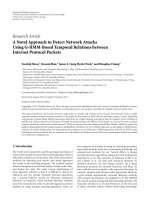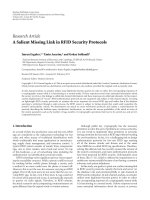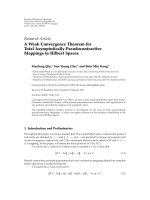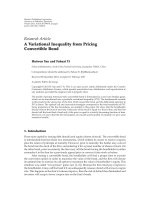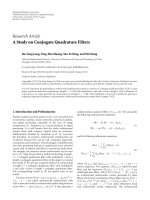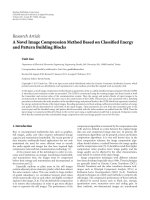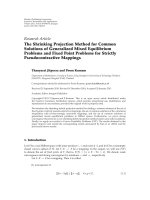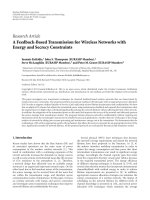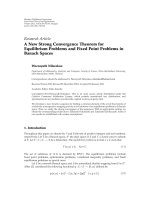Báo cáo hóa học: " Research Article A Cohen Type Inequality for Fourier Expansions of Orthogonal Polynomials with a Nondiscrete Jacobi-Sobolev Inner Product" potx
Bạn đang xem bản rút gọn của tài liệu. Xem và tải ngay bản đầy đủ của tài liệu tại đây (558.52 KB, 22 trang )
Hindawi Publishing Corporation
Journal of Inequalities and Applications
Volume 2010, Article ID 128746, 22 pages
doi:10.1155/2010/128746
Research Article
A Cohen Type Inequality for Fourier
Expansions of Orthogonal Polynomials with a
Nondiscrete Jacobi-Sobolev Inner Product
Bujar Xh. Fejzullahu
1
and Francisco Marcell
´
an
2
1
Department of Mathematics, Faculty of Mathematics and Natural Sciences, University of Prishtina,
Mother Teresa 5, Prishtin
¨
e 10000, Kosovo
2
Departamento de Matem
´
aticas, Escuela Polit
´
ecnica Superior, Universidad Carlos III de Madrid,
Avenida de la Universidad 30, 28911 Legan
´
es, Spain
Correspondence should be addressed to Francisco Marcell
´
an,
Received 5 May 2010; Accepted 24 August 2010
Academic Editor: J
´
ozef Bana
´
s
Copyright q 2010 B. Xh. F ejzullahu and F. Marcell
´
an. This is an open access article distributed
under the Creative Commons Attribution License, which permits unrestricted use, distribution,
and reproduction in any medium, provided the original work is properly cited.
Let {Q
α,β
n
x}
n≥0
denote the sequence of polynomials orthogonal with respect to the non-discrete
Sobolev inner product f, g
1
−1
fxgxdμ
α,β
xλ
1
−1
f
xg
xdμ
α1,β
x,whereλ>0
and dμ
α,β
x1 − x
α
1 x
β
dx with α>−1, β>−1. In this paper, we prove a Cohen
type inequality for the Fourier expansion in terms of the orthogonal polynomials {Q
α,β
n
x}
n
.
Necessary conditions for the n orm convergence of such a Fourier expansion are given. Finally, the
failure of almost everywhere convergence of the Fourier expansion of a function in terms of the
orthogonal polynomials associated with the above Sobolev inner product is proved.
1. Introduction
Let dμ
α,β
x1 − x
α
1 x
β
dx with α, β > −1 be the Jacobi measure supported on the
interval −1, 1. We say that f ∈ L
p
dμ
α,β
if f is measurable on −1, 1 and f
L
p
dμ
α,β
< ∞,
where
f
L
p
dμ
α,β
⎧
⎪
⎪
⎪
⎪
⎨
⎪
⎪
⎪
⎪
⎩
1
−1
f
x
p
dμ
α,β
x
1/p
, if 1 ≤ p<∞,
esssup
−1<x<1
f
x
, if p ∞.
1.1
2 Journal of Inequalities and Applications
Let us introduce the Sobolev-type spaces see, for instance, 1, Chapter III, in a more general
framework as follows:
S
α,β
p
f :
f
p
S
α,β
p
f
p
L
p
dμ
α,β
λ
f
p
L
p
dμ
α1,β
< ∞
, 1 ≤ p<∞,
S
α,β
∞
f :
f
S
α,β
∞
max
f
L
∞
dμ
α,β
,
f
L
∞
dμ
α1,β
< ∞
,
1.2
where λ>0, as well as the linear space S
α,β
p
of all bounded linear operators T : S
α,β
p
→ S
α,β
p
,
with the usual operator norm
T
S
α,β
p
sup
0
/
f∈S
α,β
p
T
f
S
α,β
p
f
S
α,β
p
.
1.3
Let f and g be in S
α,β
2
. Let us consider the following Sobolev-type inner product:
f, g
1
−1
f
x
g
x
dμ
α,β
x
λ
1
−1
f
x
g
x
dμ
α1,β
x
,
1.4
where λ>0. Let {Q
α,β
n
x}
∞
n0
denote the sequence of polynomials orthogonal with respect to
1.4, normalized by the condition that Q
α,β
n
has the same leading coefficient as the following
classical Jacobi polynomial:
P
α,β−1
n
x
1
2
n
2n α β − 1
n
x
n
lower degree terms. 1.5
We call them the Jacobi-Sobolev orthogonal polynomials.
The measures μ
α,β
and μ
α1,β
constitute a particular case of the so-called coherent pairs
of measures studied in 2.In3see also 4, the authors established the asymptotics of the
zeros of such Jacobi-Sobolev polynomials.
The aim of our contribution is to obtain a lower bound for the norm of the partial sums
of the Fourier expansion in terms of Jacobi-Sobolev polynomials, the well-known Cohen type
inequality in the framework of Approximation Theory. A Cohen type inequality has been
established in other contexts, for example, on compact groups or for classical orthogonal
expansions. See 5–10 and references therein.
Throughout the paper, positive constants are denoted by c, c
1
, and they may vary
at every occurrence. The notation u
n
∼
v
n
means that the sequence u
n
/v
n
converges to 1 and
u
n
∼ v
n
means c
1
u
n
≤ v
n
≤ c
2
u
n
for sufficiently large n, where c
1
and c
2
are positive real
numbers.
The structure of the paper is as follows. In Section 2, we introduce the basic
background about Jacobi polynomials to be used in the paper. In particular, we focus our
attention in some estimates and the strong asymptotics on −1, 1 for such polynomials as
well as the Mehler-Heine formula. In Section 3, we analyze the polynomials orthogonal with
respect to the inner product 1.4. Their representation in terms of Jacobi polynomials yields
Journal of Inequalities and Applications 3
estimates, inner strong asymptotics, and a Mehler-Heine type formula. Some estimates of the
weighted p Sobolev norm of these polynomials will be needed in the sequel and we show
them in Proposition 3.12.InSection 4, a Cohen-type inequality, associated with the Fourier
expansions in terms of the Jacobi-Sobolev orthogonal polynomials, is deduced. In Section 5,
we focus our attention in the norm convergence of the above Fourier expansions. Finally,
Section 6 is devoted to the analysis of the divergence almost everywhere of such expansions.
2. Jacobi Polynomials
For α, β > −1, we denote by {P
α,β
n
x}
∞
n0
the sequence of Jacobi polynomials which are
orthogonal on −1, 1 with respect to the measure dμ
α,β
. They are normalized in such a way
that P
α,β
n
1
nα
n
. We denote the nth monic Jacobi polynomial by
P
α,β
n
x
h
α,β
n
−1
P
α,β
n
x
,
2.1
where see 11, formula 22.3.1
h
α,β
n
1
2
n
2n α β
n
. 2.2
Now, we list some basic properties of Jacobi polynomials which will be used in the sequel. The
following integral formula for Jacobi polynomials holds see 2.1 and 11, formula 22.2.1:
1
−1
P
α,β
n
x
2
dμ
α,β
x
2
2nαβ1
Γ
n 1
Γ
n α 1
Γ
n β 1
Γ
n α β 1
Γ
2n α β 1
Γ
2n α β 2
.
2.3
They satisfy a connection formula see 11, formula 22.7.19, 3, formula 2.5 as
follows:
P
α, β−1
n
x
P
α, β
n
x
a
n−1
α, β
P
α, β
n−1
x
,
2.4
where
a
n
α, β
2
n 1
n α 1
2n α β 1
2n α β 2
,n≥ 0,
2.5
as well as the following relation for the derivatives see 12, formula 4.21.7:
d
dx
P
α, β−1
n
x
n α β
2
P
α1,β
n−1
x
.
2.6
4 Journal of Inequalities and Applications
The following estimate for P
α,β
n
holds see 12, formula 7.32.6, 13:
P
α,β
n
x
≤ cn
−1/2
1 − x
−α/2−1/4
1 x
−β/2−1/4
, 2.7
where x ∈ −1, 1 and α, β ≥−1/2.
The formula of Mehler-Heine for Jacobi orthogonal polynomials is see 12, Theorem
8.1.1 as follows:
lim
n →∞
n
−α
P
α,β
n
cos
z
n
z
2
−α
J
α
z
, 2.8
where α, β are real numbers, and J
α
z is the Bessel function. This formula holds locally
uniformly, that is, on every compact subset of the complex plane.
The inner strong asymptotics of P
α,β
n
,forθ ∈ , π − and >0, arereadasfollows
see 12, Theorem 8.21.8:
P
α,β
n
cos θ
π
−1/2
n
−1/2
sin
θ
2
−α−1/2
cos
θ
2
−β−1/2
cos
kθ γ
O
n
−1
, 2.9
where k n α β 1/2, and γ −α 1/2π/2.
For α, β, μ > −1and1≤ q ≤∞see 12, page 391. Exercise 91, as well as 10, 2.2
1
0
1 − x
μ
P
α,β
n
x
p
dx
1/p
∼
⎧
⎪
⎪
⎪
⎪
⎨
⎪
⎪
⎪
⎪
⎩
n
−1/2
, if 2μ>pα− 2
p
2
,
n
−1/2
log n
1/p
, if 2μ pα − 2
p
2
,
n
α−2μ2/p
, if 2μ<pα− 2
p
2
.
2.10
3. Asymptotics of Jacobi-Sobolev Orthogonal Polynomials
Let us denote by
Q
α, β
n
the monic Jacobi-Sobolev polynomial of degree n, that is,
Q
α, β
n
x
h
α, β−1
n
−1
Q
α,β
n
x. From 2.4 and 3, formula 2.7 see also 4, 14 in a more general
framework, we have the following relation between the Jacobi-Sobolev and Jacobi monic
orthogonal polynomials.
Proposition 3.1. For α, β > −1,
P
α,β
n
x
a
n−1
α, β
P
α,β
n−1
x
Q
α,β
n
x
d
n−1
λ
Q
α,β
n−1
x
,n≥ 1,
3.1
where a
n−1
α, β is given in 2.5 and
d
n
λ
a
n
α, β
P
α,β
n
2
L
2
dμ
α,β
Q
α,β
n
2
S
α
2
,n≥ 0.
3.2
Journal of Inequalities and Applications 5
Proposition 3.2. One gets:
Q
α,β
n
2
S
α,β
2
∼
λn
2
P
α1,β
n−1
2
L
2
dμ
α1,β
.
3.3
In particular, for
d
n
λ defined in 3.2 one obtains
d
n
λ
∼
1
4λn
2
.
3.4
Proof. We apply the same argument as in the proof of Theorem 2 in 15. Using the extremal
property
P
α,β
n
2
L
2
dμ
α,β
inf
P
2
L
2
dμ
α,β
:degP n, P monic
,
3.5
we get the following:
Q
α,β
n
2
S
α,β
2
Q
n
α,β
2
L
2
dμ
α,β
λ
Q
n
α,β
2
L
2
dμ
α1,β
≥
P
α,β
n
2
L
2
dμ
α,β
λn
2
P
α1,β
n−1
2
L
2
dμ
α1,β
.
3.6
On the other hand, from the extremal property of
Q
α,β
n
2
S
α,β
2
, 2.4,and2.6, we have
Q
α,β
n
2
S
α,β
2
≤
P
α,β
n
a
n−1
α, β
P
α,β
n−1
2
S
α,β
2
P
α,β
n
a
n−1
α, β
P
α,β
n−1
2
L
2
dμ
α,β
λn
2
P
α1,β
n−1
2
L
2
dμ
α1,β
≤
P
α,β
n
2
L
2
dμ
α,β
a
n−1
α, β
2
P
α,β
n−1
2
L
2
dμ
α,β
λn
2
P
α1,β
n−1
2
L
2
dμ
α1,β
.
3.7
Since by 2.3 and 2.5 we have
P
α,β
n
L
2
dμ
α,β
∼
P
α1,β
n−1
L
2
dμ
α1,β
and a
n
α, β
∼
1/2, then
3.6 and 3.7 yield 3.3.
As a straightforward consequence of Propositions 3.1 and 3.2,using2.1 we deduce
the following.
Corollary 3.3. For α, β > −1,
n α β
2n α β
P
α,β
n
x
n α
2n α β
P
α,β
n−1
x
Q
α,β
n
x
d
n−1
λ
Q
α,β
n−1
x
,
3.8
6 Journal of Inequalities and Applications
where n ≥ 1 and
d
n
λ
d
n
λ
h
α,β−1
n
h
α,β−1
n−1
∼
1
2λn
2
.
3.9
Corollary 3.4. For α>−1 and β>0,
P
α,β−1
n
x
Q
α,β
n
x
d
n−1
λ
Q
α,β
n−1
x
,n≥ 1,
3.10
and for α, β > −1,
n α β
2
P
α1,β
n−1
x
Q
α,β
n
x
d
n−1
λ
Q
α,β
n−1
x
,n≥ 1.
3.11
Proof. The first statement follows from Proposition 3.1 and 2.4. The second one follows by
taking derivatives in 3.10 and using 2.6.
Using 3.10 in a recursive way, the representation of the polynomials Q
α,β
n
in terms
of the elements of the sequence {P
α,β−1
n
x}
∞
n0
becomes
Q
α,β
n
x
n
k0
−1
k
b
n
k
λ
P
α,β−1
n−k
x
,
3.12
where b
n
k
λ
k
j1
d
n−j
λ and b
n
0
λ1.
Proposition 3.5. There exists a constant c>1 such that the coefficients b
n
k
λ in 3.11 satisfy
b
n
k
λ <c1/n2
k
for all n ≥ 1 and 1 ≤ k ≤ n.
Proof. From 3.9, we have lim
n
2n 1d
n
λ0. Thus, there exist n
0
∈ N and a constant
c>1 such that 2n 1d
n
λ < 1 for all n ≥ n
0
and 2n 1d
n
λ <cfor n 1, ,n
0
− 1.
Therefore, for 1 ≤ k ≤ n − n
0
,
b
n
k
λ
k
j1
d
n−j
λ
<
1
n2
k
,
3.13
and for n − n
0
≤ k ≤ n,
b
n
k
λ
n−n
0
j1
d
n−j
λ
k
jn−n
0
1
d
n−j
λ
≤
1
n2
n−n
0
c
2
k−nn
0
c
k−nn
0
1
n2
k
≤ c
n
0
1
n2
k
.
3.14
Journal of Inequalities and Applications 7
Proposition 3.6. a For the polynomials Q
α,β
n
, one obtains
Q
α,β
n
x
≤ cn
−1/2
1 − x
−α/2−1/4
1 x
−β/21/4
, 3.15
for x ∈ −1, 1,α≥−1/2, and β ≥ 1/2.
b For the polynomials Q
α,β
n
, one has the following estimate:
Q
n
α,β
x
≤ cn
1/2
1 − x
−α/2−3/4
1 x
−β/2−1/4
, 3.16
for x ∈ −1, 1,α>−1, and β ≥−1/2.
Proof. a Using 3.12, we have the following:
Q
α,β
n
cos θ
≤
n
k0
b
n
k
λ
P
α,β−1
n−k
cos θ
.
3.17
From 2.7, it is straightforward to prove that, for α, β ≥−1/2andk 0, 1, ,n− 1,
P
α,β
n−k
cos θ
≤ c
n
n − k
n
−1/2
θ
−α−1/2
π − θ
−β−1/2
.
3.18
Thus, according to Proposition 3.5,
Q
α,β
n
cos θ
≤
n
k0
b
n
k
λ
P
α,β−1
n−k
cos θ
≤ cb
n
n
λ
cn
−1/2
θ
−α−1/2
π − θ
−β1/2
n−1
k0
1
2
k
≤ cn
−1/2
θ
−α−1/2
π − θ
−β1/2
.
3.19
On the other hand, from 3.11, the proof of the case b can be done in a similar
way.
Proposition 3.7. Let α, β > −1, then
Q
α,β
n
x
≤
⎧
⎪
⎪
⎪
⎪
⎪
⎨
⎪
⎪
⎪
⎪
⎪
⎩
cn
α
, for x ∈
0, 1
,α≥−
1
2
,
cn
β−1
, for x ∈
−1, 0
,β≥
1
2
,
cn
−1/2
, for x ∈
−1, 1
,α≤−
1
2
,β≤
1
2
,
Q
n
α,β
x
≤
⎧
⎪
⎨
⎪
⎩
cn
α1
, for x ∈
0, 1
,α>−1,
cn
β1
, for x ∈
−1, 0
,β≥−
1
2
.
3.20
8 Journal of Inequalities and Applications
Proof. Taking into account that the Jacobi polynomials satisfy the following see 12,
paragraph below Theorem 7.32.1:
P
α,β
n
x
≤
⎧
⎪
⎪
⎪
⎪
⎪
⎨
⎪
⎪
⎪
⎪
⎪
⎩
cn
α
, for x ∈
0, 1
,α≥−
1
2
,
cn
β
, for x ∈
−1, 0
,β≥−
1
2
,
cn
−1/2
, for x ∈
−1, 1
,α≤−
1
2
,β≤−
1
2
,
3.21
for n ≥ 1, thus, for 0 ≤ j ≤ n − 1,
P
α,β
n−j
x
≤
⎧
⎪
⎪
⎪
⎪
⎪
⎪
⎪
⎪
⎨
⎪
⎪
⎪
⎪
⎪
⎪
⎪
⎪
⎩
c
n − j
n
α
n
α
, for x ∈
0, 1
,α≥−
1
2
,
c
n − j
n
β
n
β
, for x ∈
−1, 0
,β≥−
1
2
,
c
n − j
n
−1/2
n
−1/2
, for x ∈
−1, 1
,α≤−
1
2
,β≤−
1
2
.
3.22
As a consequence, the statement follows from the latter estimates and arguments similar to
those we used in the proof of Proposition 3.6.
Corollary 3.8. For α ≥−1/2 and β ≥ 1/2,
Q
α,β
n
cos θ
≤ cA
n, α, β − 1,θ
, 3.23
and for α>−1 and β ≥−1/2,
Q
n
α,β
cos θ
≤ cA
n, α 1,β,θ
, 3.24
where
A
n, α, β, θ
⎧
⎪
⎪
⎪
⎪
⎨
⎪
⎪
⎪
⎪
⎩
n
−1/2
θ
−α−1/2
π − θ
−β−1/2
, if
c
n
≤ θ ≤ π −
c
n
,
n
α
, if 0 ≤ θ ≤
c
n
,
n
β
, if π −
c
n
≤ θ ≤ π.
3.25
Proof. The inequality
n
α
≤ cn
−1/2
θ
−α−1/2
3.26
Journal of Inequalities and Applications 9
holds for θ ∈ 0,c/n, as well as
n
β
≤ cn
−1/2
π − θ
−β−1/2
3.27
holds for θ ∈ π − c/n, π. Therefore, the statement follows from Propositions 3.6 and 3.7.
Next, we show that the Jacobi-Sobolev polynomial Q
α,β
n
x attains its maximum in
−1, 1 at the end points. To be more precise, consider the following.
Proposition 3.9. a For α ≥−1/2,β≥ 1/2, and q max{α, β − 1},
max
−1≤x≤1
Q
α,β
n
x
Q
α,β
n
a
∼ n
q
,
3.28
where a 1 if q α, and a −1 if q β − 1.
b For α>−1,β ≥−1/2, and q max{α 1,β},
max
−1≤x≤1
Q
n
α,β
x
Q
n
α,β
b
∼ n
q1
,
3.29
where b 1 if q α 1, and b −1 if q β.
Proof. a We will prove only the case q α. If q β − 1, the the proof can be done in a similar
way. From 3.9, 3.10,andProposition 3.7,
Q
α,β
n
x
P
α,β−1
n
x
− d
n−1
λ
Q
α,β
n−1
x
P
α,β−1
n
x
− O
n
α−2
. 3.30
Now, from 12, Theorem 7.32.1 and Proposition 3.7, the result follows.
Taking into account 2.6, the case b can be proved in a similar way.
Next, we deduce a Mehler-Heine type formula for Q
α,β
n
and Q
α,β
n
.
Proposition 3.10. Let α, β > −1. Uniformly on compact s ubsets of C, one gets
a
lim
n →∞
n
−α
Q
α,β
n
cos
z
n
z
2
−α
J
α
z
, 3.31
b
lim
n →∞
n
−α−2
Q
n
α,β
cos
z
n
z
2
−α1
J
α1
z
. 3.32
Proof. a Multiplying in 3.8 by n 1
−α
, we obtain
V
n
z
Y
n
z
D
n−1
λ
Y
n−1
z
, 3.33
10 Journal of Inequalities and Applications
where V
n
zn1
−α
n α β/2n α βP
α,β
n
cosz/n n α/2n α βP
α,β
n−1
×cosz/n,Y
n
zn 1
−α
Q
α,β
n
cosz/n and D
n−1
λd
n−1
λn/n 1
α
∼
c/n
2
according to 3.9.
Using the above relation in a recursive way, we obtain
Y
n
z
n
k0
−1
k
B
n
k
λ
V
n−k
z
,
3.34
where B
n
k
λ
k
j1
D
n−j
λ and B
n
0
λ1. Moreover, by using the same argument as in
Proposition 3.5, we have B
n
k
λ <c1/n2
k
for every n ≥ 1and1≤ k ≤ n. Thus,
|
Y
n
z
|
≤
n
k0
B
n
k
λ
|
V
n−k
z
|
.
3.35
On the other hand, from 2.8, we have that {V
n
z}
∞
n0
is uniformly bounded on
compact subsets of C. Thus, for a fixed compact set K ⊂ C, there exists a constant C,
depending only on K, such that when z ∈ K,
|
V
n
z
|
<C, n≥ 1. 3.36
Thus, the sequence {Y
n
z}
∞
n0
is uniformly bounded on K ⊂ C. As a conclusion,
Y
n
z
V
n
z
O
n
−2
,z∈ K, 3.37
and using 2.8, we obtain the result.
b Since we have uniform convergence in 3.31, taking derivatives and using some
properties of Bessel functions, we obtain 3.32.
Now, we give the inner strong asymptotics of Q
α,β
n
on −1, 1.
Proposition 3.11. Let θ ∈ , π − and >0. For α ≥−1/2,β≥ 1/2, one has
Q
α,β
n
cos θ
π
−1/2
n
−1/2
sin
θ
2
−α−1/2
cos
θ
2
−β1/2
cos
k
1
θ γ
O
n
−1
, 3.38
and for α>−1,β ≥−1/2, one has
Q
n
α,β
cos θ
π
−1/2
n α β 1
n − 1
−1/2
2
sin
θ
2
−α−3/2
cos
θ
2
−β−1/2
cos
k
1
θ γ
1
O
n
−1
,
3.39
where k
1
n α β/2,γ −α 1/2π/2, and γ
1
−α 3/2π/2.
Journal of Inequalities and Applications 11
Proof. From Proposition 3.6a, the sequence {n
1/2
Q
α,β
n
x}
∞
n1
is uniformly bounded on
compact subsets of −1, 1. Multiplication by n
1/2
in 3.10 yields
n
1/2
Q
α,β
n
x
n
1/2
P
α,β−1
n
x
− d
n−1
λ
n
n − 1
n − 1
1/2
Q
α,β
n−1
x
.
3.40
Since
d
n−1
λ
n
n − 1
O
1
n
2
,
3.41
we have
n
1/2
Q
α,β
n
x
n
1/2
P
α,β−1
n
x
O
n
−2
. 3.42
Now, 3.38 follows from 2.9.
Concerning 3.39, it can be obtained in a similar way by using 3.11 and
Proposition 3.6b.
Next, we obtain an estimate for the Sobolev norms of the Jacobi-Sobolev polynomials.
Proposition 3.12. For α>−1/2,α 1 ≥ β ≥−1/2, and 1 ≤ p ≤∞, one has
Q
α,β
n
S
α,β
p
∼
⎧
⎪
⎪
⎪
⎪
⎪
⎪
⎪
⎨
⎪
⎪
⎪
⎪
⎪
⎪
⎪
⎩
n
1/2
, if
4
α 2
2α 3
>p,
n
1/2
log n, if
4
α 2
2α 3
p,
n
α2−2α4/p
, if
4
α 2
2α 3
<p.
3.43
Notice that if p ∞, then we have Proposition 3.9b. Thus, in the proof we will
assume 1 ≤ p<∞.
Proof. In order to establish the upper bound in 3.38, it is enough to prove that
Q
α,β
n
S
α,β
p
≤ cn
P
α1,β
n
L
p
dμ
α1,β
.
3.44
Using 3.8 in a recurrence way and then Minkowski’s inequality, we obtain
Q
α,β
n
L
p
dμ
α,β
≤ c
n
k0
b
n
k
λ
P
α,β
n−k
L
p
dμ
α,β
c
n
k0
b
n
k
λ
P
α,β
n−k−1
L
p
dμ
α,β
.
3.45
12 Journal of Inequalities and Applications
On the other hand, for α, β > −1andk 0, 1, ,n,2.10 implies
n − k
1/2
P
α,β
n−k
L
p
dμ
α,β
≤ cn
1/2
P
α,β
n
L
p
dμ
α,β
.
3.46
Thus,
P
α,β
n−k
L
p
dμ
α,β
≤
n
n − k
P
α,β
n
L
p
dμ
α,β
, 0 ≤ k ≤ n − 1.
3.47
On the other hand, from Proposition 3.5,
n
k0
b
n
k
λ
P
α,β
n−k
L
p
dμ
α,β
≤ cb
n
n
λ
n−1
k0
b
n
k
λ
P
α,β
n−k
L
p
dμ
α,β
≤ c
P
α,β
n−1
L
p
dμ
α,β
n−1
i0
1
2
k
≤ c
P
α,β
n
L
p
dμ
α,β
.
3.48
Thus,
Q
α,β
n
L
p
dμ
α,β
≤ c
P
α,β
n
L
p
dμ
α,β
≤ cn
P
α1,β
n
L
p
dμ
α1,β
.
3.49
In the same way as above, we conclude that
Q
n
α,β
L
p
dμ
α1,β
≤ cn
n
k0
b
n
k
λ
P
α1,β
n−k−1
L
p
dμ
α1,β
≤ cn
P
α1,β
n
L
p
dμ
α1,β
.
3.50
Thus, 3.44 follows from 3.49 and 3.50.
In order to prove the lower bound in relation 3.43, we will need the following.
Proposition 3.13. For α>−1 and 1 ≤ p<∞, one has
Q
n
α,β
L
p
dμ
α1,β
≥ c
⎧
⎪
⎪
⎪
⎪
⎪
⎪
⎪
⎨
⎪
⎪
⎪
⎪
⎪
⎪
⎪
⎩
n
1/2
, if
4
α 2
2α 3
>p,
n
1/2
log n, if
4
α 2
2α 3
p,
n
α2−2α4/p
, if
4
α 2
2α 3
<p.
3.51
Journal of Inequalities and Applications 13
Proof. We will use a technique similar to 12, Theorem 7.34. According to 3.11,
π/2
0
θ
2α3
Q
n
α,β
cos θ
p
dθ >
ω/n
0
θ
2α3
Q
n
α,β
cos θ
p
dθ
≥ cn
−2α−4
ω
0
t
2α3
Q
n
α,β
cos
t
n
p
dt
∼
cn
pα2−2α−4
ω
0
t
2α3
t
−α1
J
α1
t
p
dt
cn
pα2−2α−4
ω
0
t
2α3−pα1
|
J
α1
t
|
p
dt.
3.52
On the other hand, Stempak’s lemma see 16, Lemma 2.1,forγ>−1 − pα and 1 ≤ p<∞,
implies
ω
0
t
γ
|
J
α1
t
|
p
dt ∼
⎧
⎪
⎨
⎪
⎩
c, if γ<
p
2
− 1,
c log ω, if γ
p
2
− 1.
3.53
Thus, for 4α 2/2α 3 ≤ p and ω large enough, 3.51 follows.
Finally, from 3.39 we obtain the following:
π/2
0
θ
2α3
Q
n
α,β
cos θ
p
dθ >
π/2
π/4
θ
2α3
Q
n
α,β
cos θ
p
dθ ∼ n
p/2
.
3.54
For the proof of Proposition 3.12,from3.51,forα>−1and1≤ p<∞, we get
Q
α,β
n
S
α,β
p
≥ c
⎧
⎪
⎪
⎪
⎪
⎪
⎪
⎪
⎨
⎪
⎪
⎪
⎪
⎪
⎪
⎪
⎩
n
1/2
, if
4
α 2
2α 3
>p,
n
1/2
log n, if
4
α 2
2α 3
p,
n
α2−2α4/p
, if
4
α 2
2α 3
<p.
3.55
Thus, using 3.44 and 3.55, the statement follows.
4. A Cohen Type Inequality for Jacobi-Sobolev Expansions
For f ∈ S
α,β
1
, its Fourier expansion in terms of Jacobi-Sobolev polynomials is
∞
k0
f
k
Q
α,β
k
x
,
4.1
14 Journal of Inequalities and Applications
where
f
k
Q
α,β
k
2
S
α,β
2
−1
f, Q
α,β
k
,k 0, 1,
4.2
The Ces
`
aro means of order δ of the expansion 4.1 is defined by see 17, pages 76-
77,
σ
δ
n
f
x
n
k0
C
δ
n−k
C
δ
n
f
k
Q
α,β
k
x
,
4.3
where C
δ
k
kδ
k
.
For a function f ∈ S
α,β
p
and a fixed sequence {c
k,n
}
n
k0
,n ∈ N ∪{0}, of real numbers
with c
n−1,n
on
2
c
n,n
, we define the operators T
α,β
n
by
T
α,β
n
f
n
k0
c
k,n
f
k
Q
α,β
k
.
4.4
Let q
0
4α 8/2α 3 and let p
0
be the conjugate of q
0
. Now, we can state our main
result.
Theorem 4.1. For α>−1/2 and α 1 ≥ β ≥−1/2, one has
T
α,β
n
S
α
p
≥ c
|
c
n,n
|
⎧
⎪
⎪
⎪
⎨
⎪
⎪
⎪
⎩
n
2α4/p−2α5/2
, if 1 ≤ p<p
0
,
log n
2α3/4α8
, if p p
0
,p q
0
,
n
2α3/2−2α4/p
, if q
0
<p≤∞.
4.5
Corollary 4.2. Let α, β, p
0
,q
0
, and p be as in Theorem 4.1. For c
k,n
1,k 0, ,n, and for p
outside the interval p
0
,q
0
, one has
σ
0
n
S
α,β
p
−→ ∞ ,n−→ ∞ .
4.6
For c
k,n
C
δ
n−k
/C
δ
n
, 0 ≤ k ≤ n, Theorem 4.1 yields the following.
Corollary 4.3. For α>−1/2 and α 1 ≥ β ≥−1/2, one has
0 <δ<
2α 4
p
−
2α 5
2
, if 1 ≤ p<p
0
,
0 <δ<
2α 3
2
−
2α 4
p
, if q
0
<p≤∞,
4.7
Journal of Inequalities and Applications 15
and p
/
∈ p
0
,q
0
,
σ
δ
n
S
α,β
p
−→ ∞ ,n−→ ∞ .
4.8
We will use t he following as test functions see 10, formula 2.8,and11, formula
22.7.19:
g
α,β−1,j
n
x
1 − x
2
j
P
αj,β−1j
n
x
2j
m0
c
m,j
α, β − 1,n
P
α,β−1
nm
x
2j
m0
c
m,j
α, β − 1,n
A
nm
α, β
P
α,β
nm
x
B
nm
α, β
P
α,β
nm−1
x
,
4.9
where j ∈ N \{1}, and
c
0,j
α, β, n
4
j
Γ
n α j 1
Γ
n β j 1
Γ
2n α β 2
Γ
n α 1
Γ
n β 1
Γ
2n α β 2j 2
,
c
1,j
α, β, n
−
4
j
A
−j−1
1
n 1
Γ
n α j 1
Γ
n β j 1
Γ
2n α β 3
2n α β j 2
Γ
n α 1
Γ
n β 2
Γ
2n α β 2j 2
4
j
A
−j−1
1
n 1
Γ
n α j 1
Γ
n β j 2
Γ
2n α β 4
2n α β j 3
Γ
n α 2
Γ
n β 2
Γ
2n α β 2j 3
,
c
2j,j
α, β, n
−4
j
Γ
n 2j 1
Γ
2n 2j α β 1
Γ
n 1
Γ
2n 4j α β 1
,
A
n
α, β
n α β
2n α β
,B
n
α, β
n α
2n α β
.
4.10
Applying the operator T
α,β
n
to g
α,β−1,j
n
, for some j>α 5/2 − 2α 2/p, we get
T
α,β
n
g
α,β−1,j
n
n
k0
c
k,n
g
α,β−1,j
n
k
Q
α,β
k
,
4.11
where
g
α,β−1,j
n
k
Q
α,β
k
2
S
α,β
2
−1
g
α,β−1,j
n
,Q
α,β
k
,k 0, 1, ,n,
4.12
and using 2.3 and 3.3, we deduce
Q
α,β
n
2
S
α,β
2
∼
λ2
αβ
n.
4.13
16 Journal of Inequalities and Applications
Taking into account 4.9,for0≤ k ≤ n − 2,
1
−1
g
α,β−1,j
n
x
Q
α,β
k
x
dμ
α,β
x
0.
4.14
If k n − 1, then we get
1
−1
g
α,β−1,j
n
x
Q
α,β
n−1
x
dμ
α,β
x
c
0,j
α, β, n
A
n−1
α, β
B
n
α, β
,
×
1
−1
P
α,β
n−1
x
P
α,β
n−1
x
dμ
α,β
x
∼
2
αβ2j−2
n
−1
.
4.15
If k n, then
1
−1
g
α,β−1,j
n
x
Q
α,β
n
x
dμ
α,β
x
c
0,j
α, β, n
A
n
α, β
2
1
−1
P
α,β
n
x
P
α,β
n
x
dμ
α,β
x
c
0,j
α, β, n
B
n
α, β
2
1
−1
P
α,β
n−1
x
P
α,β
n−1
x
dμ
α,β
x
− c
0,j
α, β, n
A
n−1
α, β
B
n
α, β
b
n
1
λ
1
−1
P
α,β
n−1
x
P
α,β
n−1
x
dμ
α,β
x
c
1,j
α, β, n
A
n
α, β
B
n1
α, β
1
−1
P
α,β
n
x
P
α,β
n
x
dμ
α,β
x
∼
2
αβ2j−1
n
−1
.
4.16
On the other hand, for 0 ≤ k ≤ n − 1,
1
−1
g
α,β−1,j
n
x
Q
α,β
k
x
dμ
α1,β
x
0,
4.17
and for k n,
1
−1
g
α,β−1,j
n
x
Q
α,β
n
x
dμ
α1,β
x
n α β
2
2
c
0,j
α, β − 1,n
1
−1
P
α1,β
n−1
x
P
α1,β
n−1
x
dμ
α1,β
x
∼
2
αβ2j−1
n.
4.18
Journal of Inequalities and Applications 17
Thus,
g
α,β−1,j
n
,Q
α,β
k
0, if 0 ≤ k ≤ n − 2,
g
α,β−1,j
n
,Q
α,β
n−1
∼
2
αβ2j−2
n
−1
,
g
α,β−1,j
n
,Q
α,β
n
∼
2
αβ2j−1
n.
4.19
As a conclusion,
g
α,β−1,j
n
k
0, if 0 ≤ k ≤ n − 2,
g
α,β−1,j
n
n − 1
∼
2
2j−2
λn
2
,
g
α,β−1,j
n
n
∼
2
2j−2
λ
.
4.20
Now, we will estimate
g
α,β−1,j
n
p
S
α,β
p
g
α,β−1,j
n
p
L
p
dμ
α,β
λ
g
α,β−1,j
n
p
L
p
dμ
α1,β
.
4.21
From 10, formula 3.1,
g
α,β−1,j
n
p
L
p
dμ
α,β
≤ cn
−p/2
,
4.22
for j>α 1/2 − 2α 2/p ≥ β − 1/2 − 2β 2/p.
On the other hand, from 2.6, 4.9,and12, formula 4.5.4, one has
g
α,β−1,j
n
x
1 − x
2
j
P
αj,β−1j
n
x
−2j
1 − x
2
j−1
xP
αj,β−1j
n
x
n α β 2j
2
1 − x
2
j
P
α1j,βj
n
x
4j
n α j
2n α β 2j
1 − x
2
j−1
P
α−1j,β−1j
n
x
−
4j
n 1
2n α β 2j
1 − x
2
j−1
P
α−1j,β−1j
n1
x
− 2j
1 − x
2
j−1
P
αj,β−1j
n
x
n α β 2j
2
1 − x
2
j
P
α1j,βj
n
x
.
4.23
18 Journal of Inequalities and Applications
From 2.10,forj>max{α 3/2 − 2α 4/p, β 3/2 − 2β 2/p},
1 − x
2
j−1
P
α−1j,β−1j
n
L
p
dμ
α1,β
∼ n
−1/2
,
4.24
for α 1 ≥ β and j>α 5/2 − 2α 4/p,
1 − x
2
j−1
P
αj,β−1j
n
L
p
dμ
α1,β
∼ n
−1/2
,
4.25
and for α 1 ≥ β and j>α 3/2 − 2α 4/p,
1 − x
2
j
P
α1j,βj
n
L
p
dμ
α1,β
∼ n
−1/2
.
4.26
Thus, for α 1 ≥ β and j>α 5/2 − 2α 4/p,
g
α,β−1,j
n
L
p
dμ
α1,β
≤ cn
1/2
.
4.27
By using 4.22 and 4.27,wefindfrom4.21 that
g
α,β−1,j
n
S
α,β
p
≤ cn
1/2
,
4.28
for α 1 ≥ β and j>α 5/2 − 2α 4/p.
Now, we can prove our main result.
Proof of Theorem 4.1. By duality, it is enough to assume that q
0
≤ p ≤∞. From 4.11, 4.20,
and 4.28, one has
T
α,β
n
S
α,β
p
≥
g
α,β−1,j
n
S
α,β
p
−1
T
α,β
n
g
α,β−1,j
n
S
α,β
p
≥ cn
−1/2
c
n,n
g
α,β−1,j
n
n
Q
α,β
n
S
α,β
p
− cn
−1/2
c
n−1,n
g
α,β−1,j
n
n − 1
Q
α,β
n−1
S
α,β
p
∼ cn
−1/2
|
c
1
c
n,n
|
Q
α,β
n
S
α,β
p
1 −
c
2
c
n−1,n
c
1
n
2
c
n,n
.
4.29
Now from Proposition 3.12, the statement of the theorem follows.
Journal of Inequalities and Applications 19
5. Necessary Conditions for the Norm Convergence
The problem of the convergence in the norm of partial sums of the Fourier expansions in
terms of Jacobi polynomials has been discussed by many authors. See, for instance, 18–20
and the references therein.
Let q
α,β
n
be the Jacobi-Sobolev orthonormal polynomials, that is,
q
α,β
n
x
Q
α,β
n
S
α,β
2
−1
Q
α,β
n
x
.
5.1
For f ∈ S
α,β
1
, the Fourier expansion in terms of Jacobi-Sobolev orthonormal poly-
nomials is
∞
k0
f
k
q
α,β
k
x
,
5.2
where
f
k
f, q
α,β
k
,k 0, 1, 5.3
Let S
n
f be the nth partial sum of the expansion 5.2 as follows:
S
n
f, x
n
k0
f
k
q
α,β
k
x
.
5.4
Theorem 5.1. Let α>−1/2,α 1 ≥ β ≥−1/2, and 1 <p<∞. If there exists a constant c>0 such
that
S
n
f
S
α,β
p
≤ c
f
S
α,β
p
,
5.5
for every f ∈ S
α,β
p
,thenp ∈ p
0
,q
0
.
Proof. For the proof, we apply the same argument as in 19. Assume that 5.5 holds, then
f, q
α,β
n
q
α,β
n
x
S
α,β
p
S
n
f − S
n−1
f
S
α,β
p
≤ 2c
f
S
α,β
p
.
5.6
Therefore,
q
α,β
n
x
S
α,β
p
q
α,β
n
x
S
α
q
< ∞,
5.7
where p is the conjugate of q.
20 Journal of Inequalities and Applications
On the other hand, from 3.43 we obtain the Sobolev norms of Jacobi-Sobolev
orthonormal polynomials as follows:
q
α,β
n
S
α,β
p
∼
⎧
⎪
⎪
⎪
⎨
⎪
⎪
⎪
⎩
c, if p<q
0
,
log n, if p q
0
,
n
α3/2−2α4/p
, if p>q
0
,
5.8
for α>−1/2,α 1 ≥ β ≥−1/2, and 1 ≤ p ≤∞. Now, from 5.8 it follows that the inequality
5.7 holds if and only if p ∈ p
0
,q
0
.
The proof of Theorem 5.1 is complete.
6. Divergence Almost Everywhere
For λ 0andα β 0, Pollard 21 showed that for each p<4/3 there exists a function
f ∈ L
p
dx such that its Fourier expansion 4.27 diverges almost everywhere on −1, 1.Later
on, Meaney 22 extended the result to p 4/3. Furthermore, he proved that this is a special
case of a divergence result for the Fourier expansion in terms of Jacobi polynomials. The
failure of almost everywhere convergence of the Fourier expansions associated with systems
of orthogonal polynomials on −1, 1 and Bessel systems has been discussed in 16, 23.
If the sequence {S
n
f}
n≥0
is uniformly bounded on a set, say E, of positive measure
in −1, 1, then
f
n
q
α,β
n
x
S
α,β
∞
,E
<c, n∈ N,x∈ E.
6.1
Therefore,
f
n
q
n
α,β
x
<c, n∈ N, 6.2
almost everywhere on E. From Egorov’s Theorem, it follows that there is a subset E
1
⊂ E of
positive measure such that
f
n
q
n
α,β
x
<c, 6.3
uniformly for x ∈ E
1
. On the other hand, from 3.39
f
n
cos
k
1
θ γ
1
O
n
−1
<c, 6.4
uniformly for cos θ ∈ E
1
. Using the Cantor-Lebesgue Theorem, as described in 24,Section
1.5, see also 17, page 316,weobtain
f
n
<c. 6.5
Journal of Inequalities and Applications 21
Theorem 6.1. Let α>−1/2 and α 1 ≥ β ≥−1/2. There is an f ∈ S
α,β
p
, 1 ≤ p ≤ p
0
, whose Fourier
expansion 5.2 diverges almost everywhere on −1, 1 in the norm of S
α,β
∞
.
Proof. Consider the linear functionals
T
n
f
f
n
f, q
α,β
n
, 6.6
on S
α,β
p
, 1 ≤ p ≤ p
0
. By using 1, Theorem 3.8, we have
T
n
q
α,β
n
S
α,β
p
,q
0
≤ p ≤∞.
6.7
Thus, from 5.8,
sup
n
T
n
∞.
6.8
As a consequence of the Banach-Steinhaus theorem, there exists f ∈ S
α,β
p
, 1 ≤ p ≤ p
0
, such that
sup
n
T
n
f
∞.
6.9
Since this result contradicts 6.5, then for this f the Fourier series diverges almost
everywhere on −1, 1 in the norm of S
α,β
∞
.
Acknowledgments
The authors thank the careful revision of the paper by the referees. Their remarks and
suggestions have contributed to improve the presentation. The work of the second author F.
Marcell
´
an has been supported by Direcci
´
on General de Investigaci
´
on, Ministerio de Ciencia
e Innovaci
´
on of Spain, Grant no. MTM2009-12740-C03-01.
References
1 R. A. Adams, Sobolev Spaces, vol. 6 of Pure and Applied Mathematics, Academic Press, New York, NY,
USA, 1975.
2 H. G. Meijer, “Determination of all coherent pairs,” Journal of Approximation Theory,vol.89,no.3,pp.
321–343, 1997.
3 D. H. Kim, K. H. Kwon, F. Marcell
´
an, and G. J. Yoon, “Zeros of J acobi-Sobolev orthogonal
polynomials,” International Mathematical Journal, vol. 4, no. 5, pp. 413–422, 2003.
4 H. G. Meijer and M. G. de Bruin, “Zeros of Sobolev orthogonal polynomials following from coherent
pairs,” Journal of Computational and Applied Mathematics, vol. 139, no. 2, pp. 253–274, 2002.
5 P. J. Cohen, “On a conjecture of Littlewood and idempotent measures,” American Journal of
Mathematics, vol. 82, pp. 191–212, 1960.
6 B. Dreseler and P. M. Soardi, “A Cohen type inequality for ultraspherical series,” Archiv der
Mathematik, vol. 38, no. 3, pp. 243–247, 1982.
22 Journal of Inequalities and Applications
7 B. Dreseler and P. M. Soardi, “A Cohen-type inequality for Jacobi expansions and divergence of
Fourier series on compact symmetric spaces,” Journal of Approximation Theory, vol. 35, no. 3, pp. 214–
221, 1982.
8 S. Giulini, P. M. Soardi, and G. Travaglini, “A Cohen type inequality for compact Lie groups,”
Proceedings of the American Mathematical Society, vol. 77, no. 3, pp. 359–364, 1979.
9 G. H. Hardy and J. E. Littlewood, “A new proof of a theorem on rearrangements,” Journal of the London
Mathematical Society, vol. 23, pp. 163–168, 1948.
10 C. Markett, “Cohen type inequalities for Jacobi, Laguerre and Hermite expansions,” SIAM Journal on
Mathematical Analysis, vol. 14, no. 4, pp. 819–833, 1983.
11 M. Abramowitz and I. A. Stegun, Handbook of Mathematical Functions, Dover, New York, NY, USA,
1964.
12 G. Szeg
˝
o, Orthogonal Polynomials, vol. 23 of American Mathematical Society, Colloquium Publications,
American Mathematical Society, Providence, RI, USA, 4th edition, 1975.
13 P. Nevai, T. Erd
´
elyi, and A. P. Magnus, “Generalized Jacobi weights, Christoffel functions, and Jacobi
polynomials,” SIAM Journal on Mathematical Analysis, vol. 25, no. 2, pp. 602–614, 1994.
14 A. Iserles, P. E. Koch, S. P. Nørsett, and J. M. Sanz-Serna, “On polynomials orthogonal with respect to
certain Sobolev inner products,” Journal of Approximation Theory, vol. 65, no. 2, pp. 151–175, 1991.
15 A. Mart
´
ınez-Finkelshtein, J. J. Moreno-Balc
´
azar, and H. Pijeira-Cabrera, “Strong asymptotics for
Gegenbauer-Sobolev orthogonal polynomials,” Journal of Computational and Applied Mathematics, vol.
81, no. 2, pp. 211–216, 1997.
16 K. Stempak, “On convergence and divergence of Fourier-Bessel series,” Electronic Transactions on
Numerical Analysis, vol. 14, pp. 223–235, 2002.
17 A. Zygmund, Trigonometric Series: Vols. I, II, Cambridge University Press, London, UK, 2nd edition,
1968.
18 B. Muckenhoupt, “Mean convergence of Jacobi series,” Proceedings of the American Mathematical
Society, vol. 23, pp. 306–310, 1969.
19
J. Newman and W. Rudin, “Mean convergence of orthogonal series,” Proceedings of the American
Mathematical Society, vol. 3, pp. 219–222, 1952.
20 H. Pollard, “The mean convergence of orthogonal series. III,” Duke Mathematical Journal, vol. 16, pp.
189–191, 1949.
21 H. Pollard, “The convergence almost everywhere of Legendre series,” Proceedings of the American
Mathematical Society, vol. 35, pp. 442–444, 1972.
22 C. Meaney, “Divergent Jacobi polynomial series,” Proceedings of the American Mathematical Society, vol.
87, no. 3, pp. 459–462, 1983.
23 J. J. Guadalupe, M. P
´
erez, F. J. Ruiz, and J. L. Varona, “Two notes on convergence and divergence a.e.
of Fourier series with respect to some orthogonal systems,” Proceedings of the American Mathematical
Society, vol. 116, no. 2, pp. 457–464, 1992.
24 Ch. Meaney, “Divergent Ces
`
aro and Riesz means of Jacobi and Laguerre expansions,” Proceedings of
the American Mathematical Society, vol. 131, no. 10, pp. 3123–3218, 2003.
